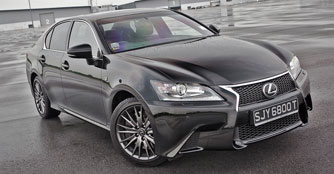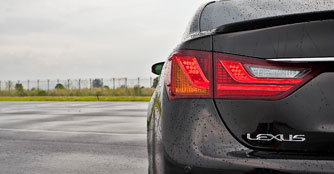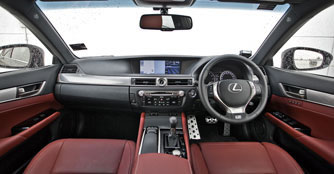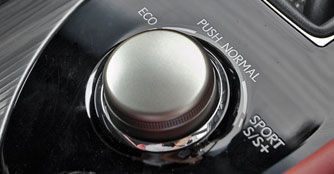Lexus GS 350 F Sport (A) Review
08 Jun 2012|23,944 views
The first generation GS began in 1993, introducing the Japanese brand into the unsympathetic luxury segment. It wasn't until 98 when the second generation, using a new platform, saw daylight. That was also the time when Lexus incorporated a V8 engine for the first time outside the Ramen ground. But it was the third generation GS that set the benchmark for Lexus, breaking new grounds for the Japanese marque, and sending it straight to the likes of BMW and Mercedes-Benz, thanks to its powerplant variations which included V6, V8 and hybrid versions.
The fourth and latest generation GS that you see here was only premiered last year in California at the Pebble Beach Concours d'Elegance, an annual automotive charitable event. Considering it to be the most prestigious event of its kind, it fits the bill of the 2012 GS, making it a rather compelling case to opt for the Japanese brand rather than a European class.
The current model, like its predecessor, is available with a variation of engines, although only V6 powerplants are accessible in Singapore for now. Where it differentiates itself, though, are the emphasis on its performance and handling over its immediate predecessor and its attitude. Despite not having the kind of deep heritage that the Germans so often and proudly highlight, Lexus never once disappointed the public. And the carmaker certainly isn't going to start with this GS.
Exterior
The front fascia is indeed aggressive. Fans of Lexus are bound to love the bold new look of the GS, especially younger drivers. Unlike previous generations of GS, the updated model takes certain cues from the smaller CT200h and has mutated the front end to form an hour-glass body. This L-finesse design philosophy has created a 'spindle' that will be the forefront of Lexus future models in the next few years.
The fourth and latest generation GS that you see here was only premiered last year in California at the Pebble Beach Concours d'Elegance, an annual automotive charitable event. Considering it to be the most prestigious event of its kind, it fits the bill of the 2012 GS, making it a rather compelling case to opt for the Japanese brand rather than a European class.
The current model, like its predecessor, is available with a variation of engines, although only V6 powerplants are accessible in Singapore for now. Where it differentiates itself, though, are the emphasis on its performance and handling over its immediate predecessor and its attitude. Despite not having the kind of deep heritage that the Germans so often and proudly highlight, Lexus never once disappointed the public. And the carmaker certainly isn't going to start with this GS.
Exterior
The front fascia is indeed aggressive. Fans of Lexus are bound to love the bold new look of the GS, especially younger drivers. Unlike previous generations of GS, the updated model takes certain cues from the smaller CT200h and has mutated the front end to form an hour-glass body. This L-finesse design philosophy has created a 'spindle' that will be the forefront of Lexus future models in the next few years.
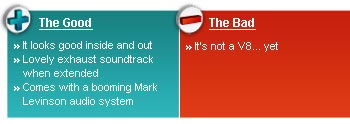 |
Equipped with the F Sport bodykit, the test car - complete with size 19 shoes - looks sharp, if not bold. It immediately strikes as a seductive machine that sports the combination of upper and lower grilles into a single element, flanked by brake cooling ducts by either side ends.
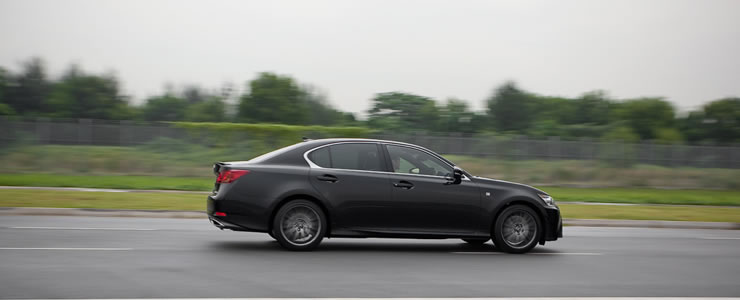 |
Round the back, it does resemble the 3 Series a tad. While it's rather boxy at the back end, taillights have been decorated with flowing 'L' lights and have been streamlined to keep itself on par with its strong rivals. From here, the GS350 also exudes an extremely sporty stance when stock-still, credit going to the wide and classy twin tail pipes thrusting from each end of the valance.
Comparing it to the car it replaces, the length and wheelbase have remained the same while the body is slightly taller and wider by 30mm and 20mm respectively. There is also an increment of 40mm on the front track and 50mm on the rear track. While track figures aren't obvious to the naked eye, the boost in body dimension is.
Reactions to the new look have positively converged. Belonging to the epitome of high-class cars, the styling of the GS350 is clearly not bland. In fact, turning heads never got easier than taking a quiet drive around the busy streets in this one, proof of what we experienced over the past couple of days when we were behind the wheel.
Interior
The cabin has been nicely sculpted and improved in more ways than one. In terms of its space, rear occupants will get to enjoy more headroom, thanks to the higher roofline of the car. Although the length and wheelbase have been brought over from the previous model, space has been maximised by slimming down the front seats to provide an extra rear knee room of 20mm. As a result, there is abundant room for four passengers and just enough for five.
Comparing it to the car it replaces, the length and wheelbase have remained the same while the body is slightly taller and wider by 30mm and 20mm respectively. There is also an increment of 40mm on the front track and 50mm on the rear track. While track figures aren't obvious to the naked eye, the boost in body dimension is.
Reactions to the new look have positively converged. Belonging to the epitome of high-class cars, the styling of the GS350 is clearly not bland. In fact, turning heads never got easier than taking a quiet drive around the busy streets in this one, proof of what we experienced over the past couple of days when we were behind the wheel.
Interior
The cabin has been nicely sculpted and improved in more ways than one. In terms of its space, rear occupants will get to enjoy more headroom, thanks to the higher roofline of the car. Although the length and wheelbase have been brought over from the previous model, space has been maximised by slimming down the front seats to provide an extra rear knee room of 20mm. As a result, there is abundant room for four passengers and just enough for five.
The new layout of the long and curvy dash is likeable. Wrapped in high-quality leather, like the rest of the cabin, it accommodates a whopping 12.3-inch multi-information display screen, the World's largest ever installed in a production vehicle, which is operated by the Remote Touch Interface (RTI) (mouse-like controller). Lexus did have a similar control for its electronics in the CT200h but this system has been refined and is user-friendlier in the GS. Where the pointer could move anywhere on the screen in the CT, it now snaps accurately to the buttons on the screen.
As a result, like its luxury German peers, controls and buttons that access various vehicle functions like climate, audio, phone and navigation are down to bare minimum, avoiding clutter and maximising tidiness. Further complimenting the cabin are the ornamental analogue Lexus-branded clock and an all-while LED interior lighting which injects a level of classiness unfounded in continental breeds.
In the music department, the GS350 was equipped with the Mark Levinson audio system. According to Lexus, this concert hall system's amplifier consumes less than a quarter of the energy required in the previous GS. It does bring out technology as Lexus' strong point and there wasn't a time when we felt that the GS was significantly behind the 5 Series or the E-Class.
As a result, like its luxury German peers, controls and buttons that access various vehicle functions like climate, audio, phone and navigation are down to bare minimum, avoiding clutter and maximising tidiness. Further complimenting the cabin are the ornamental analogue Lexus-branded clock and an all-while LED interior lighting which injects a level of classiness unfounded in continental breeds.
In the music department, the GS350 was equipped with the Mark Levinson audio system. According to Lexus, this concert hall system's amplifier consumes less than a quarter of the energy required in the previous GS. It does bring out technology as Lexus' strong point and there wasn't a time when we felt that the GS was significantly behind the 5 Series or the E-Class.
 |
The Drive
The GS350 offers a respectable 316bhp and 378Nm of torque put through a 6-speed automatic transmission and it completes the century dash in a clean six seconds. What these numbers don't convey is the V6 powerplant's willingness to play. No doubt that the smaller GS250 feels more like a gentleman's ride, the more hardcore GS350 is absolutely rewarding when driven with gusto, displaying a kind of attitude and athleticism never before experienced in previous generations of GS.
The car features a Drive Mode Select function that allows the driver to choose four different driving modes - Eco, Normal, Sport S and Sport S+. Indicative of their names, the tree-hugging Eco is the most fuel-efficient but the least responsive of the modes. Sport S and Sport S+ 'tightens' the car's suspension, steering wheel as well as the car's revs.
More excitingly, these two configurations also alter the exhaust note, letting out an animalistic but no less rich soundtrack when the accelerator is mashed. And for drivers who never stomp on the throttle, the engine will never raise its voice above a whisper and will retain its hushed atmosphere when operated at modest speeds. But it does inspire the driver to recklessly speed up whenever possible and further encourages hooliganism - leaving streaks of tyre marks all over the empty road - a character that no GS has ever exhibited before.
The GS350 offers a respectable 316bhp and 378Nm of torque put through a 6-speed automatic transmission and it completes the century dash in a clean six seconds. What these numbers don't convey is the V6 powerplant's willingness to play. No doubt that the smaller GS250 feels more like a gentleman's ride, the more hardcore GS350 is absolutely rewarding when driven with gusto, displaying a kind of attitude and athleticism never before experienced in previous generations of GS.
The car features a Drive Mode Select function that allows the driver to choose four different driving modes - Eco, Normal, Sport S and Sport S+. Indicative of their names, the tree-hugging Eco is the most fuel-efficient but the least responsive of the modes. Sport S and Sport S+ 'tightens' the car's suspension, steering wheel as well as the car's revs.
More excitingly, these two configurations also alter the exhaust note, letting out an animalistic but no less rich soundtrack when the accelerator is mashed. And for drivers who never stomp on the throttle, the engine will never raise its voice above a whisper and will retain its hushed atmosphere when operated at modest speeds. But it does inspire the driver to recklessly speed up whenever possible and further encourages hooliganism - leaving streaks of tyre marks all over the empty road - a character that no GS has ever exhibited before.
Round corners, the GS350 boasts an invigorating feeling that is uncommon in its segment. A few exploratory blasts through bends and curves reveal that the car has great traction and is immensely secure, thanks to the damper settings that came equipped with the car. It tackles the twisties with the fluidity and litheness of a much smaller car despite its weight of over 1.6 tonnes. The nose never once ran wide despite our foolish act of reckless behaviour, tracking the line with poise and precision.
For daily driving, the GS certainly does not disappoint too. The car feels imperious and will overtake slower-moving vehicles on the right lane as soon as you tickle the throttle. And like every Lexus, the car rides serenely on its suspension when driven like a gentleman. It's barely ruffled by the undulations and humps on the road.
Conclusion
There isn't a justifiable reason in our minds that can assert the fact that the GS350 loses out to the E-Class or the 5 Series. Not only is it cheaper than the Germans, it surpasses both competitors in more ways than one. While some cars are easily labelled as comfortable, luxurious and sporty, the Lexus GS350 offers a combination of the three.
This is no doubt Lexus at its purest.
For daily driving, the GS certainly does not disappoint too. The car feels imperious and will overtake slower-moving vehicles on the right lane as soon as you tickle the throttle. And like every Lexus, the car rides serenely on its suspension when driven like a gentleman. It's barely ruffled by the undulations and humps on the road.
Conclusion
There isn't a justifiable reason in our minds that can assert the fact that the GS350 loses out to the E-Class or the 5 Series. Not only is it cheaper than the Germans, it surpasses both competitors in more ways than one. While some cars are easily labelled as comfortable, luxurious and sporty, the Lexus GS350 offers a combination of the three.
This is no doubt Lexus at its purest.
The first generation GS began in 1993, introducing the Japanese brand into the unsympathetic luxury segment. It wasn't until 98 when the second generation, using a new platform, saw daylight. That was also the time when Lexus incorporated a V8 engine for the first time outside the Ramen ground. But it was the third generation GS that set the benchmark for Lexus, breaking new grounds for the Japanese marque, and sending it straight to the likes of BMW and Mercedes-Benz, thanks to its powerplant variations which included V6, V8 and hybrid versions.
The fourth and latest generation GS that you see here was only premiered last year in California at the Pebble Beach Concours d'Elegance, an annual automotive charitable event. Considering it to be the most prestigious event of its kind, it fits the bill of the 2012 GS, making it a rather compelling case to opt for the Japanese brand rather than a European class.
The current model, like its predecessor, is available with a variation of engines, although only V6 powerplants are accessible in Singapore for now. Where it differentiates itself, though, are the emphasis on its performance and handling over its immediate predecessor and its attitude. Despite not having the kind of deep heritage that the Germans so often and proudly highlight, Lexus never once disappointed the public. And the carmaker certainly isn't going to start with this GS.
Exterior
The front fascia is indeed aggressive. Fans of Lexus are bound to love the bold new look of the GS, especially younger drivers. Unlike previous generations of GS, the updated model takes certain cues from the smaller CT200h and has mutated the front end to form an hour-glass body. This L-finesse design philosophy has created a 'spindle' that will be the forefront of Lexus future models in the next few years.
The fourth and latest generation GS that you see here was only premiered last year in California at the Pebble Beach Concours d'Elegance, an annual automotive charitable event. Considering it to be the most prestigious event of its kind, it fits the bill of the 2012 GS, making it a rather compelling case to opt for the Japanese brand rather than a European class.
The current model, like its predecessor, is available with a variation of engines, although only V6 powerplants are accessible in Singapore for now. Where it differentiates itself, though, are the emphasis on its performance and handling over its immediate predecessor and its attitude. Despite not having the kind of deep heritage that the Germans so often and proudly highlight, Lexus never once disappointed the public. And the carmaker certainly isn't going to start with this GS.
Exterior
The front fascia is indeed aggressive. Fans of Lexus are bound to love the bold new look of the GS, especially younger drivers. Unlike previous generations of GS, the updated model takes certain cues from the smaller CT200h and has mutated the front end to form an hour-glass body. This L-finesse design philosophy has created a 'spindle' that will be the forefront of Lexus future models in the next few years.
 |
Equipped with the F Sport bodykit, the test car - complete with size 19 shoes - looks sharp, if not bold. It immediately strikes as a seductive machine that sports the combination of upper and lower grilles into a single element, flanked by brake cooling ducts by either side ends.
 |
Round the back, it does resemble the 3 Series a tad. While it's rather boxy at the back end, taillights have been decorated with flowing 'L' lights and have been streamlined to keep itself on par with its strong rivals. From here, the GS350 also exudes an extremely sporty stance when stock-still, credit going to the wide and classy twin tail pipes thrusting from each end of the valance.
Comparing it to the car it replaces, the length and wheelbase have remained the same while the body is slightly taller and wider by 30mm and 20mm respectively. There is also an increment of 40mm on the front track and 50mm on the rear track. While track figures aren't obvious to the naked eye, the boost in body dimension is.
Reactions to the new look have positively converged. Belonging to the epitome of high-class cars, the styling of the GS350 is clearly not bland. In fact, turning heads never got easier than taking a quiet drive around the busy streets in this one, proof of what we experienced over the past couple of days when we were behind the wheel.
Interior
The cabin has been nicely sculpted and improved in more ways than one. In terms of its space, rear occupants will get to enjoy more headroom, thanks to the higher roofline of the car. Although the length and wheelbase have been brought over from the previous model, space has been maximised by slimming down the front seats to provide an extra rear knee room of 20mm. As a result, there is abundant room for four passengers and just enough for five.
Comparing it to the car it replaces, the length and wheelbase have remained the same while the body is slightly taller and wider by 30mm and 20mm respectively. There is also an increment of 40mm on the front track and 50mm on the rear track. While track figures aren't obvious to the naked eye, the boost in body dimension is.
Reactions to the new look have positively converged. Belonging to the epitome of high-class cars, the styling of the GS350 is clearly not bland. In fact, turning heads never got easier than taking a quiet drive around the busy streets in this one, proof of what we experienced over the past couple of days when we were behind the wheel.
Interior
The cabin has been nicely sculpted and improved in more ways than one. In terms of its space, rear occupants will get to enjoy more headroom, thanks to the higher roofline of the car. Although the length and wheelbase have been brought over from the previous model, space has been maximised by slimming down the front seats to provide an extra rear knee room of 20mm. As a result, there is abundant room for four passengers and just enough for five.
The new layout of the long and curvy dash is likeable. Wrapped in high-quality leather, like the rest of the cabin, it accommodates a whopping 12.3-inch multi-information display screen, the World's largest ever installed in a production vehicle, which is operated by the Remote Touch Interface (RTI) (mouse-like controller). Lexus did have a similar control for its electronics in the CT200h but this system has been refined and is user-friendlier in the GS. Where the pointer could move anywhere on the screen in the CT, it now snaps accurately to the buttons on the screen.
As a result, like its luxury German peers, controls and buttons that access various vehicle functions like climate, audio, phone and navigation are down to bare minimum, avoiding clutter and maximising tidiness. Further complimenting the cabin are the ornamental analogue Lexus-branded clock and an all-while LED interior lighting which injects a level of classiness unfounded in continental breeds.
In the music department, the GS350 was equipped with the Mark Levinson audio system. According to Lexus, this concert hall system's amplifier consumes less than a quarter of the energy required in the previous GS. It does bring out technology as Lexus' strong point and there wasn't a time when we felt that the GS was significantly behind the 5 Series or the E-Class.
As a result, like its luxury German peers, controls and buttons that access various vehicle functions like climate, audio, phone and navigation are down to bare minimum, avoiding clutter and maximising tidiness. Further complimenting the cabin are the ornamental analogue Lexus-branded clock and an all-while LED interior lighting which injects a level of classiness unfounded in continental breeds.
In the music department, the GS350 was equipped with the Mark Levinson audio system. According to Lexus, this concert hall system's amplifier consumes less than a quarter of the energy required in the previous GS. It does bring out technology as Lexus' strong point and there wasn't a time when we felt that the GS was significantly behind the 5 Series or the E-Class.
 |
The Drive
The GS350 offers a respectable 316bhp and 378Nm of torque put through a 6-speed automatic transmission and it completes the century dash in a clean six seconds. What these numbers don't convey is the V6 powerplant's willingness to play. No doubt that the smaller GS250 feels more like a gentleman's ride, the more hardcore GS350 is absolutely rewarding when driven with gusto, displaying a kind of attitude and athleticism never before experienced in previous generations of GS.
The car features a Drive Mode Select function that allows the driver to choose four different driving modes - Eco, Normal, Sport S and Sport S+. Indicative of their names, the tree-hugging Eco is the most fuel-efficient but the least responsive of the modes. Sport S and Sport S+ 'tightens' the car's suspension, steering wheel as well as the car's revs.
More excitingly, these two configurations also alter the exhaust note, letting out an animalistic but no less rich soundtrack when the accelerator is mashed. And for drivers who never stomp on the throttle, the engine will never raise its voice above a whisper and will retain its hushed atmosphere when operated at modest speeds. But it does inspire the driver to recklessly speed up whenever possible and further encourages hooliganism - leaving streaks of tyre marks all over the empty road - a character that no GS has ever exhibited before.
The GS350 offers a respectable 316bhp and 378Nm of torque put through a 6-speed automatic transmission and it completes the century dash in a clean six seconds. What these numbers don't convey is the V6 powerplant's willingness to play. No doubt that the smaller GS250 feels more like a gentleman's ride, the more hardcore GS350 is absolutely rewarding when driven with gusto, displaying a kind of attitude and athleticism never before experienced in previous generations of GS.
The car features a Drive Mode Select function that allows the driver to choose four different driving modes - Eco, Normal, Sport S and Sport S+. Indicative of their names, the tree-hugging Eco is the most fuel-efficient but the least responsive of the modes. Sport S and Sport S+ 'tightens' the car's suspension, steering wheel as well as the car's revs.
More excitingly, these two configurations also alter the exhaust note, letting out an animalistic but no less rich soundtrack when the accelerator is mashed. And for drivers who never stomp on the throttle, the engine will never raise its voice above a whisper and will retain its hushed atmosphere when operated at modest speeds. But it does inspire the driver to recklessly speed up whenever possible and further encourages hooliganism - leaving streaks of tyre marks all over the empty road - a character that no GS has ever exhibited before.
Round corners, the GS350 boasts an invigorating feeling that is uncommon in its segment. A few exploratory blasts through bends and curves reveal that the car has great traction and is immensely secure, thanks to the damper settings that came equipped with the car. It tackles the twisties with the fluidity and litheness of a much smaller car despite its weight of over 1.6 tonnes. The nose never once ran wide despite our foolish act of reckless behaviour, tracking the line with poise and precision.
For daily driving, the GS certainly does not disappoint too. The car feels imperious and will overtake slower-moving vehicles on the right lane as soon as you tickle the throttle. And like every Lexus, the car rides serenely on its suspension when driven like a gentleman. It's barely ruffled by the undulations and humps on the road.
Conclusion
There isn't a justifiable reason in our minds that can assert the fact that the GS350 loses out to the E-Class or the 5 Series. Not only is it cheaper than the Germans, it surpasses both competitors in more ways than one. While some cars are easily labelled as comfortable, luxurious and sporty, the Lexus GS350 offers a combination of the three.
This is no doubt Lexus at its purest.
For daily driving, the GS certainly does not disappoint too. The car feels imperious and will overtake slower-moving vehicles on the right lane as soon as you tickle the throttle. And like every Lexus, the car rides serenely on its suspension when driven like a gentleman. It's barely ruffled by the undulations and humps on the road.
Conclusion
There isn't a justifiable reason in our minds that can assert the fact that the GS350 loses out to the E-Class or the 5 Series. Not only is it cheaper than the Germans, it surpasses both competitors in more ways than one. While some cars are easily labelled as comfortable, luxurious and sporty, the Lexus GS350 offers a combination of the three.
This is no doubt Lexus at its purest.
Car Information
Lexus GS 350 F Sport (A)
CAT B|Petrol|10.3km/L
Horsepower
236kW (316 bhp)
Torque
378 Nm
Acceleration
6sec (0-100km /hr)
This model is no longer being sold by local distributor
All Used Lexus GSThank You For Your Subscription.













































